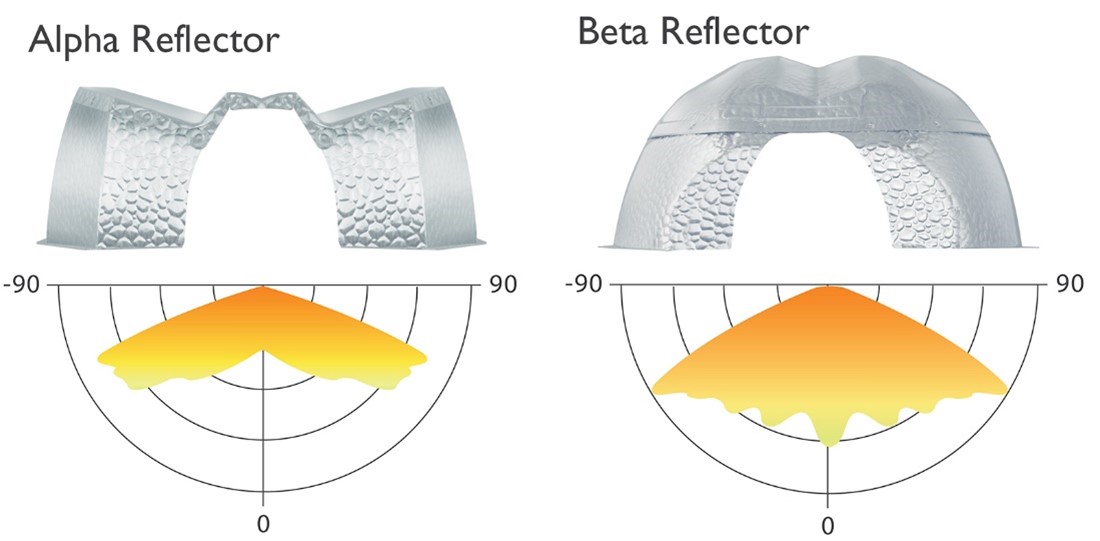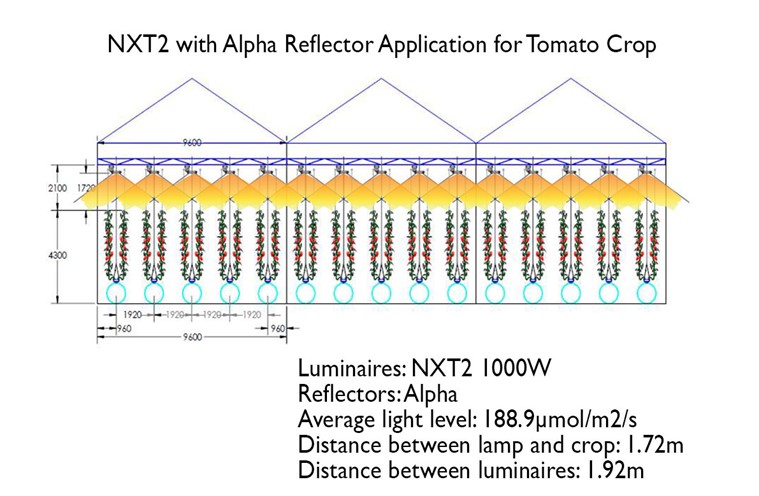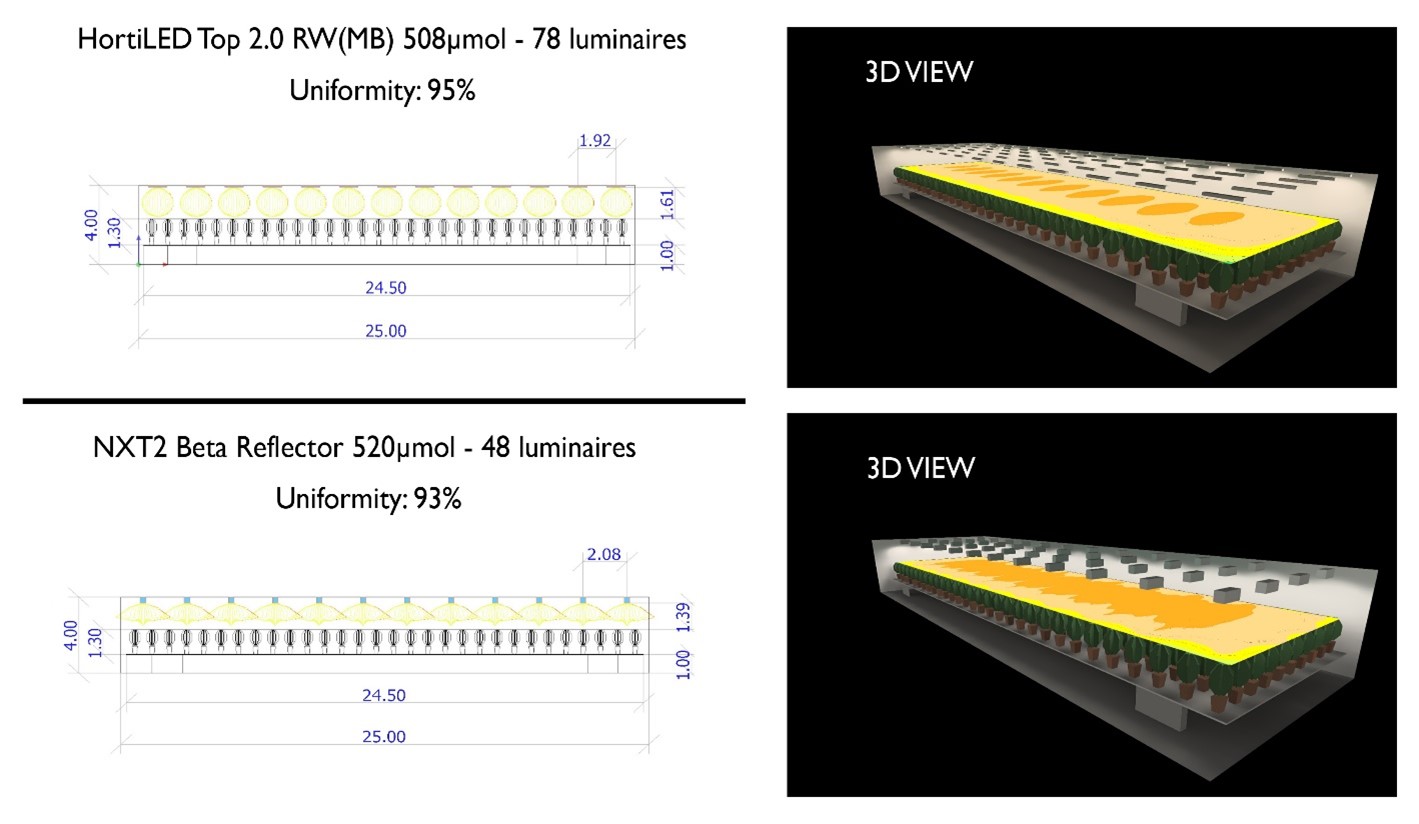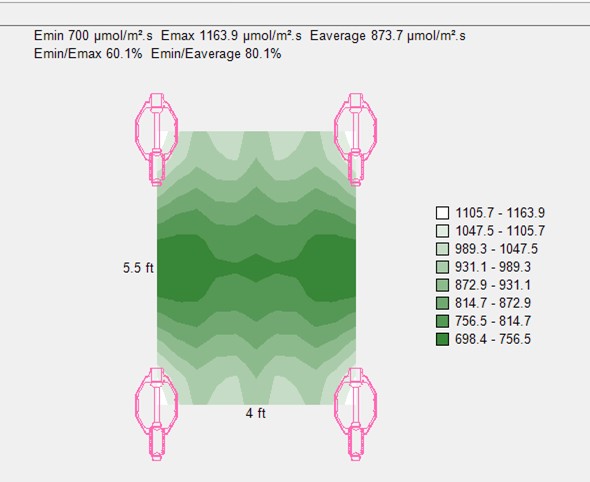Light Uniformity – Comparing HID and LED luminaires
Light uniformity is an important factor when it comes to growing a consistent crop and optimizing your growing environment, however, there has been some misinformation about the way HID and LED luminaires distribute light and affect plant health.
As a manufacturer of both HID and LED technology, P.L. Light Systems always strives to show the complete picture of both technologies. We think both HID and LED have great advantages, and which you choose will be entirely based on your application and goals as a grower. With that being said, many LED manufacturers like to paint HID grow lights as being an inferior technology – and we are here to show you that they both can be used to grow great crops. In fact, the same uniformity can be achieved with LED or HID, and it depends largely on the light plan and the mounting capabilities of your facility, rather than the luminaire itself. Almost any grow light can deliver uniform desired light levels in an existing or new infrastructure, as long as there is design freedom from the luminaire manufacturer to layout a custom light plan – as it is mounting heights and spacing that impact uniformity. However, most operations don’t have this luxury, and commercial grow lights need to be hung according to where track truss are located. That is why the angular distribution of light between HID and LED becomes important and can be a crucial component in having a good ROI for your operation.
What is light uniformity?
Light uniformity is the measure of light levels at a specific distance from a light source, at the canopy level, showing the difference in intensity between the highest and lowest measured values. For example, in a light plan with a maximum value of 1000μmol, and a minimum value of 500μmol, the uniformity would be 50%. Light uniformity is important because you need the luminaires’ light output to be distributed evenly across the surface of the crop to ensure even photosynthesis and uniform plant growth. When lighting is not uniform in a growing space, plants can dry out at different times, and you can have some plants developing faster and others slower. Uneven light creates varying daily light integrals (DLI) within a space, creating areas where intensity may be too low―consequently delaying flowering and compromising yields compared to areas of the crop receiving higher intensities.
To ensure proper light uniformity, grow light companies will create a customized light plan for your application. A light plan calculates the best possible coordination of grow lights in terms of their distance and orientation from one another as well as the crop. It should be noted that all luminaires are different in their layouts. Reflectors on HPS lights differ from one manufacturer to another and some manufacturers, like P.L. Light Systems, offer multiple reflectors with different distribution patterns to accommodate different styles of growing and layouts. This is also true with LEDs, as individual diodes for these luminaires come in different distributions. One manufacturer’s light plan may differ from another, not just with the pattern of grow light layout but also the number of luminaires it will take to reach the targeted light level and uniformity. For this reason, P.L. Light Systems advises growers to strongly consider a light plan that shows a guaranteed uniformity and light level. Take note that the target light level at the crop canopy should always be the starting point of a light plan. Then, all other factors that will affect the layout and performance of the luminaires should be considered to determine how to achieve the desired light level, with optimal uniformity and efficiency.
HID luminaires
As we know, HID luminaires have specialized reflectors to evenly distribute light over the canopy for uniform growth. All reflectors will differ in the amount of light they reflect from the lamp to the canopy of the crop. Reflector patterns, materials, and shapes will affect the dispersion of light and how it is distributed.
The light uniformity for HID lights is highly dependent on the reflector and its ability to evenly and efficiently distribute light. Light energy can be wasted with the use of a poorly designed reflector. Reflectors can be designed to allow for wider spacing of luminaires or to focus more energy down into a tall, dense crop like tomatoes or cucumbers. A well-designed light plan will have even uniformity so there is not a large difference between the lowest and highest values of light intensity measured at the crop.
Reflector design
Some reflectors, like the P.L. Light Systems’ Beta Reflector, are designed to distribute the highest percentage of light from the lamp downwards to penetrate deep within the crop canopy. Whereas the Alpha reflector is designed to provide a wider range of even light distribution over the canopy.
When we compare the design of the Alpha reflector vs. the Beta reflector, you can see that the Alpha is better suited to distributing light evenly when positioned a distance away from other luminaires and closer to a crop. Whereas the Beta reflector is built to drive light further into the canopy, which is perfect for tall, dense canopies.

To avoid wasting light on areas like walls and walkways, P.L. also offers the asymmetrical reflector, which allows you to direct light away from walls/walkways and onto your crop.
As some LED manufacturers have falsely written, the more space between each grow light and the crop surface, the more uneven the light distribution. Again, this is not typically true for HID luminaires because the reflector evenly distributes light and creates light crossover—creating high levels of uniformity. In fact, you tend to get better light dispersion from the diffused light (light coming from different directions) emitted by a reflector, because it will cover a greater amount of plant surface. Many of our greenhouse growers who use HID luminaires have them installed at a significant height in the greenhouse and receive excellent uniformity over the crop. As you can see below, the NXT2 with Alpha reflector provides an even crossover of light with a uniformity of around 90% and an average light level of 188.9 µmol/m2/s when installed at a height of 1.72meters or 5.6ft above the canopy and positioned 1.92m, or about 6.2 feet apart.

LED Luminaires
In general, you will need fewer HPS than LED luminaires to achieve the same uniform light intensity over a crop. This is because the spacing will likely be different for an LED installation vs. that of an HPS, due to the difference in the light distribution patterns between the two sources. As mentioned, light penetration into the crop comes from the crossover between fixtures, which is easily accomplished by HPS luminaires. Whereas LED grow lights will likely need to be arranged in a different configuration, due to the directional distribution of light, in order to achieve higher uniformity over the crop canopy. This arrangement will be specific to the design of the luminaire.
So, if properly installed according to a light plan, LEDs will provide the same uniformity over a crop as HID luminaires, but will likely have different spacing requirements and can require up to 2-3 more lights to achieve the same uniformity at the same desired light level.
Example:
Let’s look at an example taken from our light planning software, comparing the HortiLED Top 2.0 RW(MB) luminaire to the NXT2 luminaire with HPS lamps and Beta reflectors.
Again, note that based on several variables such as desired light level, crop height, and mounting height, similar uniformity and light levels can be achieved when installing either LEDs or HPS, as it has more to do with the placement than the type of grow light. You cannot remove one type of luminaire and replace it with the other and expect to get the same light level or uniformity. But if you have the flexibility to mount the luminaires anywhere on the XY coordinate, then you can achieve great results with any choice that has a decent light distribution.

As you can see, the uniformity on the LED installation is 95% and the HPS installation has 93% uniformity, so both applications have very similar uniformity and light intensities. The difference is that it takes nearly twice as many LED luminaires to achieve the same uniformity as the HIDs due to the difference in light output and distribution between the two technologies. This can impact your ROI, despite overall energy savings, as LEDs can cost up to twice as much as HID technology.
Light planning and uniformity
It is common practice to generate light intensity values based on a 2×2 grid located in the center of a grow facility. This has been true for many years and remains true today when determining the uniformity of a medium to large facility. The concept behind this approach is that regardless of where you decide to measure uniformity in a facility, be it bay 3, bay 5, etc., the light levels and measurements captured will be very similar. This is obviously not true around the perimeter of any light plan due to the lack of additional lighting coming from beyond the walls. And since uniformity is highly dependent on the crossover of light from multiple sources, the smaller the grow facility, the more difficult it can become to achieve uniformity over the entire crop.
The best practice in determining uniformity is to map out a grid at a specific distance from the bottom of the luminaire. At P.L. we use an 11 x 11 grid which provides a good indication of the highs and lows between mounted indoor grow lights. Four corners of the grid are located directly below the 4 luminaires (2×2 grid) and measurement points are placed between the luminaries, to ensure a decent sample size is created. From these measurements, the highest and lowest values will determine the “Uniformity” of the light plan. The Calculation is Min/Max = % uniformity. An alternate calculation sometimes used is Min/Average, which is technically correct when speaking about uniformity but can easily be used to skew the perception of how uniform the light level is over an area of the crop.
Example:

If the maximum intensity at a specific point in a measurement grid is 1164μmols and the minimum measurement is 700μmols, the uniformity that P.L. Light Systems will discuss is min/max = ~60%. However, if you were to calculate uniformity using min/avg the interpretation of the uniformity over that crop would be based on min/avg = ~80%, which paints a picture that the uniformity of light over the crop is not terrible, even though some areas over the crop will be experiencing very high light levels and others that will be receiving a light level closer to that which is desired. Whereas, if uniformity is calculated at approx. 60% through the more accurate min/max, you are left with a more realistic representation. For reference, 90% or more is generally recommended and 60% would not be ideal for most applications. It is therefore important to take time to evaluate and understand the light plan that has been provided, to ensure your crop is receiving the most uniform light possible based on the parameters of your plant growth facility.
So, when considering supplemental or sole-source lighting, make sure to get a light intensity map, as shown above, to help show expected variations in light intensity for your particular application. The lower the variation in intensity, the more uniform the light distribution. In general, a 10-20% variation is acceptable.
Takeaway
Do your homework! In the end, you can have very good light uniformity with either HID or LED technology, but it will depend on the capabilities of your facility. Flexibility in mounting location and height will greatly impact your lighting manufacturers’ ability to provide a good light plan that targets the desired light level—while also achieving excellent uniformity. Placement of luminaires is often thought of last when constructing or laying out a plant growth facility, but it is one of the most important components of a successful crop yield. Also, be sure to educate yourself on how to interpret light plans and light intensity maps so you understand what your light uniformity will be.
Get started on your custom light plan today by contacting one of your local sales managers.


